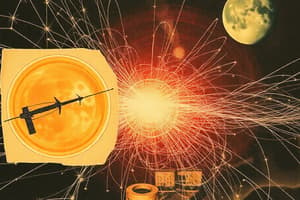Podcast
Questions and Answers
Welche der folgenden Aussagen beschreibt die Beziehung zwischen Elektrizität und Magnetismus?
Welche der folgenden Aussagen beschreibt die Beziehung zwischen Elektrizität und Magnetismus?
- Sie sind unabhängig voneinander.
- Sie sind einander entgegengesetzt.
- Sie sind miteinander verbunden und können nicht getrennt werden. (correct)
- Sie sind nur in festen Materialien vorhanden.
Die Stärke eines elektrischen Feldes wird in Coulomb gemessen.
Die Stärke eines elektrischen Feldes wird in Coulomb gemessen.
False (B)
Was beschreibt das Gauss'sche Gesetz für Elektrizität?
Was beschreibt das Gauss'sche Gesetz für Elektrizität?
Die Beziehung zwischen elektrischen Ladungen und dem elektrischen Feld.
Ein ______ erzeugt ein elektrisches Feld, das nach außen strahlt.
Ein ______ erzeugt ein elektrisches Feld, das nach außen strahlt.
Ordnen Sie die folgenden Begriffe den entsprechenden Beschreibungen zu:
Ordnen Sie die folgenden Begriffe den entsprechenden Beschreibungen zu:
Welche Einheit wird verwendet, um die Stärke eines magnetischen Feldes zu messen?
Welche Einheit wird verwendet, um die Stärke eines magnetischen Feldes zu messen?
Magnetische Feldlinien verlaufen vom Südpol zum Nordpol.
Magnetische Feldlinien verlaufen vom Südpol zum Nordpol.
Was passiert, wenn sich elektrische und magnetische Felder zeitlich ändern?
Was passiert, wenn sich elektrische und magnetische Felder zeitlich ändern?
Die Wellen haben ______ elektrische und magnetische Felder, die senkrecht zueinander stehen.
Die Wellen haben ______ elektrische und magnetische Felder, die senkrecht zueinander stehen.
Wie nennt man die vier grundlegenden Gesetze, die die Elektromagnetik regeln?
Wie nennt man die vier grundlegenden Gesetze, die die Elektromagnetik regeln?
Welche der folgenden Strahlenarten gehören zum elektromagnetischen Spektrum?
Welche der folgenden Strahlenarten gehören zum elektromagnetischen Spektrum?
Die Frequenz und die Wellenlänge elektromagnetischer Wellen sind direkt proportional.
Die Frequenz und die Wellenlänge elektromagnetischer Wellen sind direkt proportional.
Was wird durch elektromagnetische Induktion erzeugt?
Was wird durch elektromagnetische Induktion erzeugt?
Coulombs Gesetz beschreibt die _____ zwischen ruhenden elektrischen Ladungen.
Coulombs Gesetz beschreibt die _____ zwischen ruhenden elektrischen Ladungen.
Ordne die folgenden Anwendungen der Elektromagnetik ihren Beschreibungen zu:
Ordne die folgenden Anwendungen der Elektromagnetik ihren Beschreibungen zu:
Welche der folgenden Aussagen beschreibt elektromagnetische Polarisation?
Welche der folgenden Aussagen beschreibt elektromagnetische Polarisation?
Elektromagnetismus vereint Elektrizität und Magnetismus zu einem einheitlichen Konzept.
Elektromagnetismus vereint Elektrizität und Magnetismus zu einem einheitlichen Konzept.
Nenne einen Grund, warum elektromagnetische Induktion wichtig ist.
Nenne einen Grund, warum elektromagnetische Induktion wichtig ist.
Die Geschwindigkeit elektromagnetischer Wellen ist gleich der _____ des Lichts.
Die Geschwindigkeit elektromagnetischer Wellen ist gleich der _____ des Lichts.
Was vermittelt der Lorentz-Kraftgesetz?
Was vermittelt der Lorentz-Kraftgesetz?
Flashcards
Elektromagnetismus
Elektromagnetismus
Der Zweig der Physik, der die Beziehung zwischen Elektrizität und Magnetismus untersucht.
Elektrisches Feld
Elektrisches Feld
Ein Bereich um eine geladene Teilchen oder Objekt, in dem eine Kraft auf ein anderes geladenes Teilchen oder Objekt nachweisbar ist.
Magnetisches Feld
Magnetisches Feld
Ein Bereich um ein magnetisches Material oder eine bewegte elektrische Ladung, in dem die magnetische Kraft nachweisbar ist.
Maxwell-Gleichungen
Maxwell-Gleichungen
Signup and view all the flashcards
Gauss'sches Gesetz (Elektrizität)
Gauss'sches Gesetz (Elektrizität)
Signup and view all the flashcards
Gauss'sches Gesetz (Magnetismus)
Gauss'sches Gesetz (Magnetismus)
Signup and view all the flashcards
Faradaysches Induktionsgesetz
Faradaysches Induktionsgesetz
Signup and view all the flashcards
Ampère-Maxwell-Gesetz
Ampère-Maxwell-Gesetz
Signup and view all the flashcards
Elektromagnetische Wellen
Elektromagnetische Wellen
Signup and view all the flashcards
Wellenausbreitung
Wellenausbreitung
Signup and view all the flashcards
Elektromagnetisches Spektrum
Elektromagnetisches Spektrum
Signup and view all the flashcards
Elektromagnetische Induktion
Elektromagnetische Induktion
Signup and view all the flashcards
Frequenz und Wellenlänge
Frequenz und Wellenlänge
Signup and view all the flashcards
Polarisation
Polarisation
Signup and view all the flashcards
Elektromagnetische Kraft
Elektromagnetische Kraft
Signup and view all the flashcards
Coulombsches Gesetz
Coulombsches Gesetz
Signup and view all the flashcards
Lorentz-Kraft
Lorentz-Kraft
Signup and view all the flashcards
Elektromotorische Kraft (EMK)
Elektromotorische Kraft (EMK)
Signup and view all the flashcards
Maxwell'sche Gleichungen
Maxwell'sche Gleichungen
Signup and view all the flashcards
Study Notes
Introduction to Electromagnetism
- Electromagnetism is the branch of physics that studies the relationship between electricity and magnetism.
- These two forces are fundamentally interconnected and cannot be separated.
- They are described by Maxwell's equations, a set of four equations that completely describe the behavior of electric and magnetic fields.
Electric Fields
- An electric field is a region around a charged particle or object within which a force on another charged particle or object can be detected.
- A positive charge creates a field that radiates outward, while a negative charge creates a field that radiates inward.
- The strength of the electric field is measured in newtons per coulomb (N/C).
- Electric fields can be produced by stationary charges (electrostatic fields) or by changing magnetic fields (induced electric fields).
- The direction of the electric field at a point is defined as the direction of the force exerted on a positive test charge placed at that point.
Magnetic Fields
- A magnetic field is a region around a magnetic material or a moving electric charge within which the force of magnetism can be detected.
- Magnetic fields are created by moving electric charges, such as currents in wires.
- The strength of a magnetic field is measured in teslas (T).
- Magnetic field lines form closed loops around a magnet.
- These lines point from the north pole to the south pole outside the magnet.
Maxwell's Equations
- Maxwell's four equations are a set of fundamental laws governing electromagnetism.
- Gauss's law for electricity describes the relationship between electric charges and the electric field.
- Gauss's law for magnetism states that magnetic monopoles (isolated north or south poles) do not exist.
- Faraday's law of induction describes how a changing magnetic field creates an electric field, and vice versa.
- Ampère-Maxwell's law relates the magnetic field to both electric currents and changing electric fields.
Electromagnetic Waves
- When electric and magnetic fields change in time, they create electromagnetic waves.
- These waves propagate through space at the speed of light.
- The waves have oscillating electric and magnetic fields that are perpendicular to each other and to the direction of wave propagation.
- Different frequencies of electromagnetic waves correspond to different types of radiation, such as radio waves, microwaves, infrared radiation, visible light, ultraviolet radiation, X-rays, and gamma rays.
- The frequency and wavelength of electromagnetic waves are inversely proportional.
Applications of Electromagnetism
- Electromagnetism forms the basis for many technologies, including:
- Electrical generators and motors.
- Transformers.
- Radio and television transmission.
- Medical imaging (MRI).
Electromagnetic Induction
- Electromagnetic induction is the process of creating an electromotive force (EMF) or voltage across a conductor by changing the magnetic field around it.
- This process is essential for generating electrical power.
- A changing magnetic field induces an electric current.
Forces in Electromagnetism
- Electromagnetic force is one of the four fundamental forces in nature.
- It is responsible for a wide range of phenomena, including the attraction between opposite charges, the repulsion between like charges, and the force between electric currents.
- This force is described by Coulomb's law for stationary charges and the Lorentz force law for moving charges.
Key Concepts
- Electromagnetic spectrum: The range of all types of electromagnetic radiation.
- Polarization: The orientation of the electric field vector in an electromagnetic wave.
- Interference and diffraction: Phenomena that arise from the wave nature of electromagnetic radiation.
Summary
- Electromagnetism unifies electricity and magnetism into a single concept.
- Maxwell's equations are the fundamental rules.
- Electromagnetic waves travel at the speed of light.
- Applications are numerous and pervasive in modern technology.
Studying That Suits You
Use AI to generate personalized quizzes and flashcards to suit your learning preferences.




